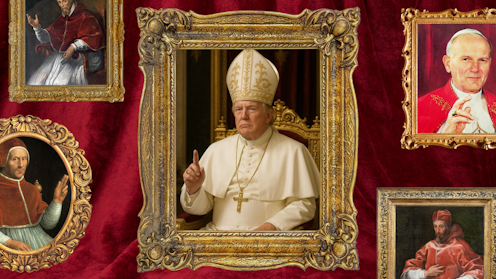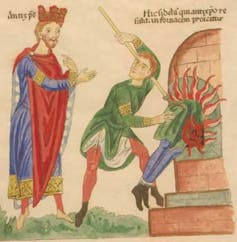Detta inlägg post publicerades ursprungligen på denna sida this site ;
Date:
Author: Philip C. Almond, Emeritus Professor in the History of Religious Thought, The University of Queensland
Original article: https://theconversation.com/what-will-the-antichrist-look-like-according-to-western-thought-an-authoritarian-king-or-the-pope-256205

The US presidency and the papacy came together on May 3 when Donald Trump posted an AI-generated photograph of himself dressed as the pope to Truth Social. The image was then shared by the White House’s accounts.
Seated in an ornate (Mar-a-Lago-style) golden chair, he was wearing a white cassock and a bishop’s hat, with his right forefinger raised.
Trump has since told reporters he “had nothing to do with it […] somebody did it in fun”.
This image of “Pope Donald I” is of historical significance, for reasons of which, no doubt, the White House and Trump were blissfully unaware. It is the first ever image to combine the two most important understandings of the figure of the Antichrist in Western thought: on the one hand, that of the pope, and on the other, that of the authoritarian, despotic world emperor.
On April 22, the day after Pope Francis’ death, Trump declared “I’d like to be pope. That would be my number one choice”. On April 28, Trump told The Atlantic “I run the country and the world”.
So, both pope and world emperor.
The Imperial Antichrist
In the New Testament, the First Letter of John says, before Christ came again, the Antichrist will appear: the most conspicuous sign the end of the world was near. nb small tweak to wording here
The Antichrist would be the archetypal evil human being who would persecute the Christian faithful. He would be finally defeated by the forces of good. As Sir Isaac Newton suggested, “searching the Prophecies which [God] hath given us to know Antichrist by” is a Christian obligation.
The first life of the Antichrist was written by a Benedictine monk, Adso of Montier-en-der, around 1,100 years ago. According to Adso, the Antichrist would be a tyrannical evil king who would corrupt all those around him with gold and silver. He would be brought up in all forms of wickedness. Evil spirits would be his instructors and his constant companions.

Wikimedia Commons
Seeking his own glory, as Adso put it, this king “will call himself Almighty God”.
The Antichrist was opposite to everything Christ-like. According to the Christian tradition, Christ was fully human yet absolutely “sin free”. The Antichrist too was fully human, but completely “sin full”. The Antichrist was not so much a supernatural being who became flesh, as a human being who became fully demonised.
Influenced by Christian stories of the Antichrist, Islam and Judaism constructed their own Antichrists – al-Dajjal, the Antichrist of the Muslims, and Armilus, the Antichrist of the Jews. Both al-Dajjal and Armilus are king-like messiahs.
Over the centuries, many world leaders have been labelled “the Antichrist” – the Roman emperors Nero and Domitian were Antichrist figures, and the French emperor Napoleon was named the Antichrist in his own time.
There have been more recent leaders who have been likened to the Antichrist, among them former president of Iraq Saddam Hussein, King Charles III, former Russian leader Mikhail Gorbachev, al-Qaeda founder Osama bin Laden, and Trump.
The Papal Antichrist
In the year 1190, King Richard I of England, on his way to the Holy Land, was informed by the Italian theologian Joachim of Fiore (c.1135–1202) the next pope would be the Antichrist.
In the history of the Antichrist, this was a momentous occasion. From this time on, the tyrannical Antichrist outside of the Church would be juxtaposed with the papal deceiver within it.
That the Catholic pope was the Antichrist was the common reading of the pope in the 16th-century Protestant Reformation.
Martin Luther (1483–1546), the founder of the Protestant revolution, declared the pope “is the true […] Antichrist who has raised himself over and set himself against Christ”.
Just as all Christians would not worship the Devil as God, he went on to say, “so we cannot allow his apostle the pope or Antichrist, to govern as our head or lord”.

Wikimedia Commons
As he was about to be burned by the Catholic Queen Mary for his Protestant beliefs, the Anglican bishop Thomas Cranmer (1489–1556) declared, “as for the pope, I refuse him, as Christ’s enemy and antichrist with all his false doctrine”.
Even in 1988, as Pope John Paul II addressed the European Parliament, the Northern Ireland hardline Protestant leader Ian Paisley roared, “Antichrist! I renounce you and all your cults and creeds” – to which, we are told, the pope gave a slight bemused smile.
Except among the most extreme of Protestant conservatives, the idea of the papal Antichrist no longer has any purchase. The papal Antichrist has vacated the Western stage for the imperial Antichrist.
The Antichrist and the end of the world
In the history of Christianity, the idea of the Antichrist was a key part of Christian expectations about the return of Christ and the end of the world.
In the final battle between the forces of good and evil, the Antichrist would be defeated by the forces of Christ. In short, the rise of the world emperor who was the Antichrist was a sign that the end of the world was at hand.
In the light of the Western history of “the Antichrist”, the image of the imperial and papal US president is a powerful sign that the global order – at least as we have known it for the last 80 years – may be at an end.
Read more:
Five things to know about the Antichrist
![]()
Philip C. Almond does not work for, consult, own shares in or receive funding from any company or organisation that would benefit from this article, and has disclosed no relevant affiliations beyond their academic appointment.